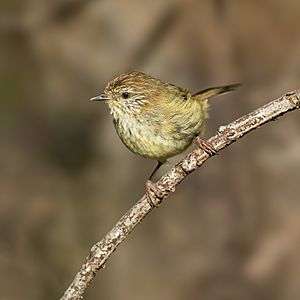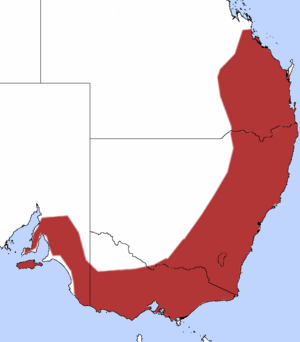Striated thornbill facts for kids
Quick facts for kids Striated thornbill |
|
|---|---|
 |
|
| Conservation status | |
| Scientific classification | |
| Genus: |
Acanthiza
|
| Species: |
lineata
|
| Subspecies | |
|
|
 |
|
| Distribution in southeast Australia | |
The striated thornbill (Acanthiza lineata) is a small, active bird that lives only in Australia. It's part of a bird family called Acanthizidae. You can find these birds in dry forests, especially where there are lots of eucalyptus trees.
Contents
About the Striated Thornbill
Naming and History
A scientist named John Gould first described the striated thornbill in 1838. He gave it the name "striated acanthiza." People have also called it the striped-crowned thornbill or the green thornbill.
Scientists use special ways to group and name animals. This helps them understand how different species are related. A recent study in 2017 looked at the DNA of these birds. It showed that the striated thornbill's ancestors separated from the yellow thornbill's ancestors about 6 million years ago.
Different Types of Striated Thornbills
There are four main types, or subspecies, of the striated thornbill. They look a little different depending on where they live in Australia:
- A. lineata alberti: This type lives in southeast Queensland. It's usually paler and more yellowish than others. It has a bright orange-brown cap with clear white streaks.
- A. lineata lineata: You can find this type across New South Wales and Victoria.
- A. lineata clelandii: This type is smaller and paler than the main type, but its back is more grayish. It lives in southeastern South Australia, near Adelaide.
- A. lineata whitei: This type is smaller and darker, with a grayish look. It lives on Kangaroo Island.
What They Look Like
The adult striated thornbill is about 9 to 10 centimeters (about 3.5 to 4 inches) long. It weighs around 7 grams, which is about as much as two pennies!
It has a reddish-brown or orange-brown cap on its head with creamy white streaks. Its upper body is a dull yellow-olive color, and its sides are olive-grey. Its belly is creamy white with many black streaks.
The brown thornbill (A. pusilla) looks a bit similar. However, the brown thornbill doesn't have the white-streaked orange-brown cap. Brown thornbills also tend to live in shrubs, while striated thornbills prefer tree canopies.
What They Eat
Striated thornbills mostly eat insects. They spend a lot of time in the tops of eucalyptus trees, carefully picking insects off the leaves. Sometimes, they even hang upside-down to reach their food!
They also visit special parts of the sunshine wattle plant (Acacia terminalis). These plants have sweet spots on their leaves called extra-floral nectaries. When the birds feed there, they help the plant by spreading pollen from one flower to another.
Life Cycle and Social Behavior
Outside of the breeding season, from late summer to winter, striated thornbills often gather in large groups of 7 to 20 birds. These groups help them stay safe and find food.
When it's time to breed, these larger groups break up. They form smaller groups of 2 to 4 birds. These smaller groups usually include a pair of birds that will lay eggs, plus other "helper" birds. These helpers often assist the parents in raising the young birds.
See also
 In Spanish: Acantiza estriada para niños
In Spanish: Acantiza estriada para niños


